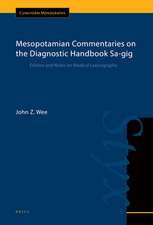Knowledge and Rhetoric in Medical Commentary: Ancient Mesopotamian Commentaries on a Handbook of Medical Diagnosis (Sa-gig), Cuneiform Monographs vol. 49/1: Cuneiform Monographs, cartea 49
Autor John Z Weeen Limba Engleză Hardback – 29 dec 2019
In line with commentators’ self-fashioning as experts of diverse disciplines, commentaries display intertextuality involving a variety of lexical, astronomical, religious, magic, and literary compositions, while employing patterns of argumentation that resist categorization within any single branch of knowledge. Commentators’ choices of topics and comments, however, sought to harmonize atypical language and ideas in the Handbook with conventional ways of perceiving and describing the sick body in therapeutic recipes. Scholastic rhetoric—supposedly unfettered to any discipline—served in fact as a pretext for affirming current forms of medical knowledge.
Din seria Cuneiform Monographs
- 18%
 Preț: 939.81 lei
Preț: 939.81 lei - 15%
 Preț: 540.47 lei
Preț: 540.47 lei - 18%
 Preț: 1652.48 lei
Preț: 1652.48 lei - 18%
 Preț: 1287.49 lei
Preț: 1287.49 lei - 18%
 Preț: 1075.02 lei
Preț: 1075.02 lei - 18%
 Preț: 929.10 lei
Preț: 929.10 lei - 18%
 Preț: 950.26 lei
Preț: 950.26 lei - 18%
 Preț: 802.67 lei
Preț: 802.67 lei - 18%
 Preț: 1156.00 lei
Preț: 1156.00 lei - 18%
 Preț: 948.27 lei
Preț: 948.27 lei - 18%
 Preț: 921.74 lei
Preț: 921.74 lei - 18%
 Preț: 1055.61 lei
Preț: 1055.61 lei - 18%
 Preț: 1151.35 lei
Preț: 1151.35 lei - 18%
 Preț: 1198.62 lei
Preț: 1198.62 lei - 18%
 Preț: 1198.85 lei
Preț: 1198.85 lei - 18%
 Preț: 1046.06 lei
Preț: 1046.06 lei - 18%
 Preț: 1263.39 lei
Preț: 1263.39 lei - 18%
 Preț: 1010.22 lei
Preț: 1010.22 lei - 18%
 Preț: 871.26 lei
Preț: 871.26 lei - 18%
 Preț: 721.44 lei
Preț: 721.44 lei - 18%
 Preț: 1053.64 lei
Preț: 1053.64 lei - 18%
 Preț: 579.22 lei
Preț: 579.22 lei - 18%
 Preț: 843.52 lei
Preț: 843.52 lei - 18%
 Preț: 1235.20 lei
Preț: 1235.20 lei - 18%
 Preț: 814.95 lei
Preț: 814.95 lei -
 Preț: 363.01 lei
Preț: 363.01 lei - 18%
 Preț: 1821.27 lei
Preț: 1821.27 lei - 18%
 Preț: 1006.78 lei
Preț: 1006.78 lei - 18%
 Preț: 883.07 lei
Preț: 883.07 lei - 18%
 Preț: 784.54 lei
Preț: 784.54 lei - 18%
 Preț: 1485.73 lei
Preț: 1485.73 lei - 18%
 Preț: 1175.72 lei
Preț: 1175.72 lei - 18%
 Preț: 631.60 lei
Preț: 631.60 lei - 18%
 Preț: 1074.03 lei
Preț: 1074.03 lei - 18%
 Preț: 862.90 lei
Preț: 862.90 lei - 18%
 Preț: 1205.68 lei
Preț: 1205.68 lei - 18%
 Preț: 1070.18 lei
Preț: 1070.18 lei - 18%
 Preț: 743.69 lei
Preț: 743.69 lei
Preț: 1142.66 lei
Preț vechi: 1393.49 lei
-18% Nou
Puncte Express: 1714
Preț estimativ în valută:
218.67€ • 227.00$ • 182.34£
218.67€ • 227.00$ • 182.34£
Carte disponibilă
Livrare economică 03-17 martie
Preluare comenzi: 021 569.72.76
Specificații
ISBN-13: 9789004417540
ISBN-10: 9004417540
Dimensiuni: 155 x 235 mm
Greutate: 0.48 kg
Editura: Brill
Colecția Brill
Seria Cuneiform Monographs
ISBN-10: 9004417540
Dimensiuni: 155 x 235 mm
Greutate: 0.48 kg
Editura: Brill
Colecția Brill
Seria Cuneiform Monographs
Notă biografică
John Z. Wee, Ph.D. (2012), Yale University, is Assistant Professor of Assyriology at the University of Chicago. He is author of books and articles on medicine and astronomy in Mesopotamian and Greco-Roman antiquity, and editor of The Comparable Body (Brill, 2017).
Recenzii
"The two-volume work of John Z. Wee is a welcome new contribution to the discussion of Babylonian and Assyrian cuneiform commentaries—an at times complex and, to readers unaware of its intricacies, often opaque textual genre, mainly known from the late time of Cuneiform Culture. (...) The first volume addresses not only Assyriologists but also scholars interested in the history of medicine and the history of interpretation and science. The study presented here includes a great many detailed discussions and presentations of interrelated issues within Mesopotamian commentary literature particularly in relation to the DH and its structure, as well as the context of these commentaries and their arguments in respect to their use and institutional background. Volume two provides the relevant data, presenting a collective edition of all commentaries on the DH so far known. This offers the particular advantage of making all relevant data accessible in a printed, citable form together with detailed philological commentaries and discussions on difficult or peculiar words and phrases."
- Eric Schmidtchen, Université de Genève, in Bibliotheca Orientalis LXXVIII N° 3-4 (2021).
"In short, John Wee’s Knowledge and Rhetorical in Medical Commentary in an erudite and refreshing analysis of Sa-gig and its commentaries. Although a highly specialized subject, some of his broader observations about serialization, canonization, textual sources of authority, and embedded variants may be helpful for folks in religious studies thinking about so-called canon, interpretive practices and textual sources of authority, and the boundaries in the ancient world of what we often designate science and literature."
- William Brown, in The Biblical Review, 2021.
- Eric Schmidtchen, Université de Genève, in Bibliotheca Orientalis LXXVIII N° 3-4 (2021).
"In short, John Wee’s Knowledge and Rhetorical in Medical Commentary in an erudite and refreshing analysis of Sa-gig and its commentaries. Although a highly specialized subject, some of his broader observations about serialization, canonization, textual sources of authority, and embedded variants may be helpful for folks in religious studies thinking about so-called canon, interpretive practices and textual sources of authority, and the boundaries in the ancient world of what we often designate science and literature."
- William Brown, in The Biblical Review, 2021.
Cuprins
I. Knowledge and Rhetoric in Medical Commentary
Preface
Acknowledgements
Contents (Two Volumes)
List of Figures
Medical Text Labels and Abbreviations
Format and Translation Issues
Glossary
I.1 Introduction to the Sa-gig Commentaries
I.1.1 The Situatedness of Commentaries
I.1.2 The Diagnostic Handbook Sa-gig and Its Serialization
I.1.3 Serialized Variants and Their Interpretation
I.1.4 The Presentation of Alternatives in Text Series and Commentaries
I.2.1 Commentary Designations and Scribal Actors
I.2.1.1 “Glossary” (ṣâtu)
I.2.1.2 “Oral Lore” (šūt pî)
I.2.1.3 “Readings” (malsûtu)
I.2.1.4 “Questionings” (mašʾaltu)
I.2.1.5 “From the Mouth of the Ummânu-scholar” (ša pî ummâni)
I.2.1.6 Patterns of Commentary Designations
I.2.2 Textual Sources of Authority
I.2.2.1 Lexical Text Citations
I.2.2.2 Narratival Intertextuality
I.2.2 Forms of Argumentation
I.2.3.1 Two-Member Arguments
I.2.3.2 Multiple Member Arguments
I.2.3.3 Single Member Arguments
I.2.4 Exemplar and License in Scholastic Hermeneutics
I.3.1 Epistemic Progression in Medical Practice and Texts
I.3.1.1 The Therapeutic Tradition
I.3.1.2 Structuring the Diagnostic Handbook
I.3.2 Harmonizing Texts and Phenomena
I.3.2.1 Knowledge Assumptions in Topic Choice
I.3.2.2 The Pericope and Omissions from Topics
I.3.2.3 Comment Choice and Argument as Pretext
I.3.1 Habits of Use and the Cuneiform Handbook
I.4 Conclusion: Scholasticism and the Boundaries for Interpretation
Appendix One: Embedded Variants in the Diagnostic Handbook Sa-gig
Appendix Two: Transliterations of Medical Texts
Bibliography
Index of Excerpts (Two Volumes)
II. Mesopotamian Commentaries on the Diagnostic Handbook Sa-gig
Preface
Acknowledgements
Contents (Two Volumes)
Medical Text Labels and Abbreviations
Format and Translation Issues
II.1.1 Commentary Sa-gig 1A
II.1.2 Commentary Sa-gig 1B
II.1.3 Commentary Sa-gig 1C
II.1.4 Commentary Sa-gig 1D
II.1.5 Commentary Sa-gig 1–3
II.1.6 Commentary Sa-gig 3A
II.1.7 Commentary Sa-gig 3B
II.1.8 Commentary Sa-gig 3C
II.1.9 Commentary Sa-gig 4A
II.1.10 Commentary Sa-gig 4B
II.1.11 Commentary Sa-gig 4C
II.1.12 Commentary Sa-gig 5
II.1.13 Commentary Sa-gig 7A
II.1.14 Commentary Sa-gig 7B
II.1.15 Commentary Sa-gig 7Ca
II.1.16 Commentary Sa-gig 7Cb
II.1.17 Commentary Sa-gig 7Cc (?)
II.1.18 Commentary Sa-gig 10 & 11
II.1.19 Commentary Sa-gig 13+
II.1.20 Commentary Sa-gig 14
II.1.21 Commentary Sa-gig 18
II.1.22 Commentary Sa-gig 19
II.1.23 Commentary Sa-gig 21 & 22a
II.1.24 Commentary Sa-gig 23
II.1.25 Commentary Sa-gig 29
II.1.26 Commentary Sa-gig 34
II.1.27 Commentary Sa-gig 36
II.1.28 Commentary Sa-gig 39
II.1.29 Commentary Sa-gig 40A
II.1.30 Commentary Sa-gig 40B
II.2.1 Disjunction Sign
II.2.2 “The Case of / Where” (ša)
II.2.3 “Which It Said” (ša iqbû)
II.2.4 “As in” (libbû)
II.2.5 “Complement to” (IGI / pāni)
II.2.6 “(Points) to” (ana)
II.2.7 “The Usual (Meaning)” (kayyān)
II.2.8 Other Notations
Photographs
Bibliography
Index of Excerpts (Two Volumes)
Preface
Acknowledgements
Contents (Two Volumes)
List of Figures
Medical Text Labels and Abbreviations
Format and Translation Issues
Glossary
I.1 Introduction to the Sa-gig Commentaries
I.1.1 The Situatedness of Commentaries
I.1.2 The Diagnostic Handbook Sa-gig and Its Serialization
I.1.3 Serialized Variants and Their Interpretation
I.1.4 The Presentation of Alternatives in Text Series and Commentaries
Chapter Two: Commentary and Scholastic Rhetoric
I.2.1 Commentary Designations and Scribal Actors
I.2.1.1 “Glossary” (ṣâtu)
I.2.1.2 “Oral Lore” (šūt pî)
I.2.1.3 “Readings” (malsûtu)
I.2.1.4 “Questionings” (mašʾaltu)
I.2.1.5 “From the Mouth of the Ummânu-scholar” (ša pî ummâni)
I.2.1.6 Patterns of Commentary Designations
I.2.2 Textual Sources of Authority
I.2.2.1 Lexical Text Citations
I.2.2.2 Narratival Intertextuality
I.2.2 Forms of Argumentation
I.2.3.1 Two-Member Arguments
I.2.3.2 Multiple Member Arguments
I.2.3.3 Single Member Arguments
I.2.4 Exemplar and License in Scholastic Hermeneutics
Chapter Three: Commentary and Medical Knowledge
I.3.1 Epistemic Progression in Medical Practice and Texts
I.3.1.1 The Therapeutic Tradition
I.3.1.2 Structuring the Diagnostic Handbook
I.3.2 Harmonizing Texts and Phenomena
I.3.2.1 Knowledge Assumptions in Topic Choice
I.3.2.2 The Pericope and Omissions from Topics
I.3.2.3 Comment Choice and Argument as Pretext
I.3.1 Habits of Use and the Cuneiform Handbook
I.4 Conclusion: Scholasticism and the Boundaries for Interpretation
Appendix One: Embedded Variants in the Diagnostic Handbook Sa-gig
Appendix Two: Transliterations of Medical Texts
Bibliography
Index of Excerpts (Two Volumes)
II. Mesopotamian Commentaries on the Diagnostic Handbook Sa-gig
Preface
Acknowledgements
Contents (Two Volumes)
Medical Text Labels and Abbreviations
Format and Translation Issues
Chapter One: Edition of the Sa-gig Commentaries
II.1.1 Commentary Sa-gig 1A
II.1.2 Commentary Sa-gig 1B
II.1.3 Commentary Sa-gig 1C
II.1.4 Commentary Sa-gig 1D
II.1.5 Commentary Sa-gig 1–3
II.1.6 Commentary Sa-gig 3A
II.1.7 Commentary Sa-gig 3B
II.1.8 Commentary Sa-gig 3C
II.1.9 Commentary Sa-gig 4A
II.1.10 Commentary Sa-gig 4B
II.1.11 Commentary Sa-gig 4C
II.1.12 Commentary Sa-gig 5
II.1.13 Commentary Sa-gig 7A
II.1.14 Commentary Sa-gig 7B
II.1.15 Commentary Sa-gig 7Ca
II.1.16 Commentary Sa-gig 7Cb
II.1.17 Commentary Sa-gig 7Cc (?)
II.1.18 Commentary Sa-gig 10 & 11
II.1.19 Commentary Sa-gig 13+
II.1.20 Commentary Sa-gig 14
II.1.21 Commentary Sa-gig 18
II.1.22 Commentary Sa-gig 19
II.1.23 Commentary Sa-gig 21 & 22a
II.1.24 Commentary Sa-gig 23
II.1.25 Commentary Sa-gig 29
II.1.26 Commentary Sa-gig 34
II.1.27 Commentary Sa-gig 36
II.1.28 Commentary Sa-gig 39
II.1.29 Commentary Sa-gig 40A
II.1.30 Commentary Sa-gig 40B
Chapter Two: Commentary Notations
II.2.1 Disjunction Sign
II.2.2 “The Case of / Where” (ša)
II.2.3 “Which It Said” (ša iqbû)
II.2.4 “As in” (libbû)
II.2.5 “Complement to” (IGI / pāni)
II.2.6 “(Points) to” (ana)
II.2.7 “The Usual (Meaning)” (kayyān)
II.2.8 Other Notations
Photographs
Bibliography
Index of Excerpts (Two Volumes)



